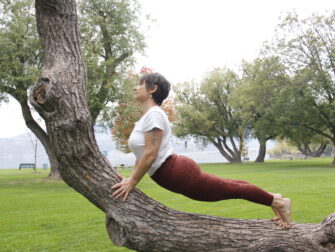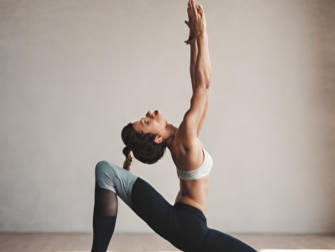Iyengar Yoga has become synonymous with prop yoga; however, there are times when props are definitely being overused. BKS iyengar has been known to exclaim “I wish I never invented props!” because he saw them often misused. In his younger years, BKS Iyengar practiced more of a vinyasa style of Yoga. Through his evolution as both a practitioner and a teacher, he realized the need for “external” props. He began by using his own body to shape a student’s poses, and bring life and energy to the asanas. He was been known to use his hands, legs, feet, knees and even his head, to adjust his student’s poses. As his classes grew from one-on-one sessions to dozens of participants, he could no longer get around to every student, hence the use of things like wood blocks, chairs and belts. Hands-on adjustments are also a hallmark of Iyengar Yoga classes, as physical adjustments are sometimes much more effective than verbal ones to get the understanding into the cells of the body.
On the one hand, props have made the asanas available to those who are not entirely flexible or strong, and especially helpful to those with more serious injuries or consitions. On the other hand, props are unnecessary for our vibrant youth population who should be encouraged to explore movement and mobility without the fuss of props. For the young people, dynamic action, fun and flow take precedence over exacting alignment. Likewise, beginners should be allowed the freedom of discovery without the burden of too many props. As they progress beyond the beginning levels, more refinement of the actions in poses will be demanded, and props are very useful for that purpose.
Props can open up closed areas and penetrate the dark and dull areas. They can help to develop elasticity and freedom in the musculo-skeletal body. If you are looking to correct deformities in the body, the legs for example, belts and blocks can provide the resistance to align the bones. The use of props is not only helpful for physical ailments; they can be used to encourage certain mental states, such as alertness or calmness.
A prop should not become a permanent crutch. What I have seen in my years of teaching is that students become very attached to their props, so much so that they do not realize when they have outgrown their use. The mindset can become rigid and then the possibility of progress is slim. Time to time, it is useful to try the poses without the props to see what has changed — be open to change. See what the prop is or is not bringing to your practice. Some people use the lack of props or equipment as an excuse not to practice at home. For example, “I don’t have 4 foam blocks so I can’t practice shoulder stand at home”. Get creative, find things around the house that serve the purpose. Use the kind of innovation that Mr. Iyengar has used to develop your practice. This way also, you can “travel light” and maintain your practice while you are away from home.
The funny thing is that while some people are attached to their props, others are very resistant to using them when they would clearly be helpful in preventing injury. For example, maybe you have very tight hamstrings and the seated forward bends strain your lower back muscles, compromising the spine. Folded blankets under the buttocks will change the angle of the legs to the spine and give the mechanical advantage needed to extend the spine forward out from the pelvis. Or perhaps you have a knee problem. That knee should be protected from further harm with the use of props. If it is a chronic problem, indeed the prop maybe be used for an indefinite period to keep the knee healthy. If a knee problem is due to a structural defect of the legs, consistent work in realigning the legs with the use of props will have a health sustaining effect. When you are practicing at home and take a prop, ask yourself, “why?” Is it because you’ve always done it that way, or do you need that prop for a specific purpose? In class, take note of when using a particular prop gives a marked beneficial effect. Ask your teacher to help you when you have an injury, and note which props have been used. See how the props may relieve pain, create a desired opening in the body, or quietness of mind.



